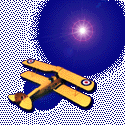

| A Day At The Races - Pylon Style |
What
Do You Need To Go Racing ?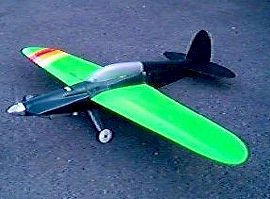
No special equipment is required before you attend your first Sport 40
pylon meeting. Most events can cater for a sports model section so you
only need to bring along any model/engine combination you are comfortable
with. The first thing to learn is how to fly the course, it's not as easy
as you might think to do it accurately. Once you have done that, you may
want to spend some money on a faster model or engine, To enter an event,
you must ring up the organiser at least one week before. For combined
Sport 40 and F3D events, at least two weeks notice is required. You usually
need to give your name, your car registration number, and the names any
passengers you may be bringing. This is essential for sites such as active
airfields where security need to know who they are inviting. Most importantly,
the organiser needs to know which frequency you intend to fly on. This
is necessary to make up heat sheets so that there are no clashes of frequency
to sort out at the event.
You need to bring the following items:
- Your model, fully charged and ready to go.
- Transmitter and alternative crystals if possible.
- Flight box with the essential tools and spare parts to keep you flying all day.
- A hard hat (Building site or motorcycle helmet).
- Something to eat and drink.
- Some money to cover the entry fee.
Fuel
and other necessary items will be provided by the organisers. Once you
have been to a meeting or two and had some practice, you will want to
go faster. By then you will have seen what others are flying and have
some idea how different models and engines perform. There are many kits
or plans to choose from and an up to date list of allowable engines is
given in the current rules.
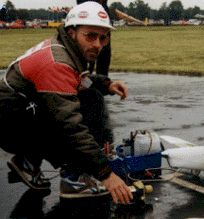 Safety
Safety
Like all forms of racing, pylon racing can be dangerous. Models fly fast
and usually quite low. When something goes wrong, there is little time
to correct the problem. Mid air collisions and radio failures happen occasionally
and models out of control could go anywhere. Everyone on or near the course
must remain alert at all times when racing is in progress. Everyone on
the course must always wear hard hats for protection. The Sport 40 Association
are acutely aware of the importance of safety and so far have never had
an incident at a Sport 40 race meeting resulting in injury or damage to
property. We hope that this situation will continue by encouraging the
diligence and safety awareness of all involved.
Dangerous flying such as over flying the course or the pits or flying
too low will be penalised. Models should always fly higher than the height
of the pylons (around 20ft). A pilot deemed to be flying dangerously will
be warned by the starter or contest director. If it happens again, a cut
may be awarded or, in extreme cases, the pilot may be grounded.
The Course
Sport 40 pylon races are held over ten laps around an elongated triangular
course. The course is 180m long and 40 m wide at the base of the triangle.
The course is set up with the number one pylon exactly upwind of the start
line whenever possible so that take off is directly towards the number
one pylon and directly into wind. The start and finish line is marked
30m in front of the base. The pits area is either sited a safe distance
away in a position where it won't be over flown or (for smaller meetings
or restricted sites) is sited inside the course. Since no one is allowed
to over fly the course, inside the course is usually the safest place
to be. The landing area is always outside the course on the opposite side
to the pits. The Sport 40 course is exactly the same as the F3D pylon
course and regular combined meetings are held when both classes are run.
Races are run anti clockwise, so you always turn left around the pylons.

Pylon Racing Course
The
Races
Each heat is held between three or four models at a time. Heats have a
staggered start to reduce the danger of mid air collisions at the number
one pylon on the first turn. Racing is against the clock, with each models
clock being started when the starters flag drops for that model. The clock
is stopped when the model crosses the start line again after completing
ten laps.
At the beginning of a heat, each model in turn is held up for identification
by one of the flagmen at the number one pylon. During the race, the flagman
will drop his flag when the model he is watching passes the number one
pylon. The pilots assistant (or caller) will shout out the instruction
to turn and the model will turn and head back towards the number two pylon.
Pilots usually fly around the number two and three pylons without much
from their callers. However, some advice on the best line into the turn
is useful, especially for beginners in the event The start is made with
the models stationary on the ground. Each model is held by the pilots
caller. The starter drops his flag for each model in turn. The caller
releases (or pushes) the model and the race is on. If a model cuts inside
one of the pylons, a cut is called and the recorded time for that model
is increased by 10%. This is to simulate the flying of a penalty lap to
make up for the short one. If a model cuts twice, no time is recorded
for that heat
After the heats are complete, each pilot will have flown around six heats.
Sometimes it's more, sometimes less. It all depends on the weather, the
number of entrants and the slickness of the organisation. If six heats
have been run, each pilots two worst times are dropped and the remainder
added up to see who the fastest are. Usually, the four fastest go on to
a final. Finals are run with a simultaneous start and the first home (if
without cuts) is the winner of the event. Sport 40 is organised into two
groups of pilots, group B for beginners in the event and group A for the
more experienced. Finals are usually held for both groups. 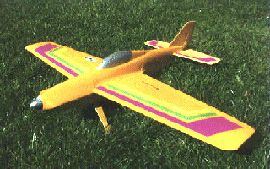 Promotion
from group B to group A is made when a certain qualifying standard is
achieved. Currently this is done at the end of the season in which the
pilot first achieves a four heat combined time at one meeting of 450 seconds
or less. There is no provision for demotion from group A to B.
Promotion
from group B to group A is made when a certain qualifying standard is
achieved. Currently this is done at the end of the season in which the
pilot first achieves a four heat combined time at one meeting of 450 seconds
or less. There is no provision for demotion from group A to B.
The sole purpose of running the heats is to decide who gets a place in
the final. It is more important to be consistent at this stage than to
be the fastest. Anyone who gets more than two no times is automatically
out of the running. If you set your engine too lean just to try and go
a little faster, you are unlikely to finish the heat and could blow your
chances of qualifying (as well as wrecking your engine).
The Officials
The officials running the meeting are usually competing as well. Obviously
they can't officiate whilst flying so the various jobs are spread around
all the competitors. Typically, the entry is split into two halves. The
first half fly three or so heats each whilst the second half officiate
and then they switch round It will be a very rare meeting where you are
not called upon to do something around the course so it is useful to know
what needs to be done and how to do it
Although it may seem rather complicated just reading this account it all
falls into place at a meeting. Come along and see.
The Contest Director
The contest director is in charge of the event. Usually he will have organised
the venue and obtained the necessary permissions As director, he is responsible
for resolving any disputes that may arise or for any interpretation of
the rules that may be required.
The Starter
The starter is responsible for everything that happens on and around the
start line. At the beginning of each heat, he will make sure the right
pilots are in the right place and that timekeepers are available. He will
conduct the process of identification whereby each flagman at the 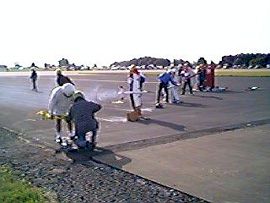 number
one pylon knows which model he is flagging for. He will ensure that each
model is on a different frequency, that transmitters and receivers are
switched on and that there are no radio problems.
number
one pylon knows which model he is flagging for. He will ensure that each
model is on a different frequency, that transmitters and receivers are
switched on and that there are no radio problems.
When everyone is ready, the starter will announce a one minute start up
time. Pilots and their callers then have 60 seconds to start engines and
get ready for the start. Once the minute is up, each model is flagged
away in turn at about 1 second intervals. If you are having problems starting
your engine and are late for the start, you are still allowed to take
off until the leading model has crossed the start line on its way back
from the number one pylon on its first lap. If you can't get away before
that time, you must stop your engine and retire from the start line. When
the heat is over, each pilot must land as quickly as possible so the next
heat can start. It is strictly forbidden to land inside the course (by
flying between pylons 2 and 3) or between the course and the pits because
there will be people moving about in those areas. The landing strip is
usually sited just outside the course on the side furthest away from the
pit area. During the pilots briefing, this area should be pointed out
to everyone. If in doubt, ask. When everyone has landed safely, models
recovered and radios switched off, the next heat can start.
The Timekeepers
Each timekeeper is responsible for timing one model over the ten laps.
The start is staggered, so the watch is started when the flag is dropped
for that model. The timekeeper must count the laps and when the ten laps
are complete, should shout to the pilot/caller to let them know they've
finished. The timekeeper must look out for any cuts made by his pilot
and note them and the time on the master time sheet.
Number One Flagmen
Waving a flag at the number one pylon is a very important and quite demanding
job. Flagmen have to be alert and organised if they are to treat each
pilot fairly. There is one flagman for each model in each heat.
When the models in a heat are identified, each model is held up in turn
so that the appropriate flagman knows which is which. When he is confident
that he can recognise the model, the flagman waves his flag as a signal
to the starter. When the heat begins, all the flagmen raise their flags.
When their model passes the number one pylon, they drop their flag smartly
as a signal to the pilot/caller. If a model cuts inside the pylon or turns
back the wrong side of the pylon, the flagman should wave his flag above
his head for a few seconds as a signal. If there is a cut hoard provided,
the cut marker should be placed on the board. As your model rounds the
base pylons, your flag should be raised again ready for the next lap.
At the end of the heat, any cuts are signalled to the base by the appropriate
flagman holding his flag aloft and waiting for an acknowledgement. If
there is a radio link provided, this is an easier way of communicating
with the base. To ensure fairness, the flagmen should flag each model
at the same point. Usually, a landmark on the horizon at 90" to the
course will be chosen and the flagmen will stand in a line so that they
can see both the pylon and the landmark. As the model crosses this imaginary
line, the flag should be dropped.
Base Flagmen
Usually one flagman is positioned on each base pylon. His task is to identify
if any models cut inside the pylon. If this occurs, a shout or a blast
on an air horn is usually sufficient to inform the timekeeper and,caller/pilot.
At the end of the heat, any cuts should be specifically mentioned to the
timekeepers so that the correct time is put on the master time sheet.
The Callers
Callers assist the pilot during model preparation, engine start, launching
and advice on where to fly. When you are starting out, it is best to have
a caller who knows what he is doing and has done it before. He will help
to calm you down and make sure you haven't forgotten anything. Any experienced
competitor will be more than willing to help out a newcomer, so you only
have to ask.
See
also 'The Ultimate Adrenaline Rush - Pylon
Racing!'.
This page has been contributed by UK Pylon Racing